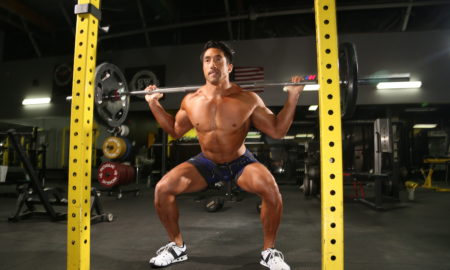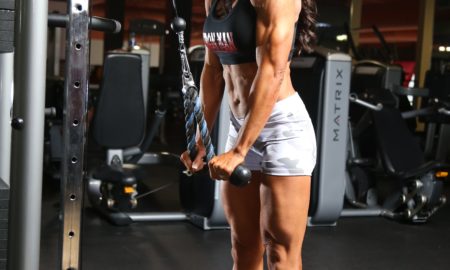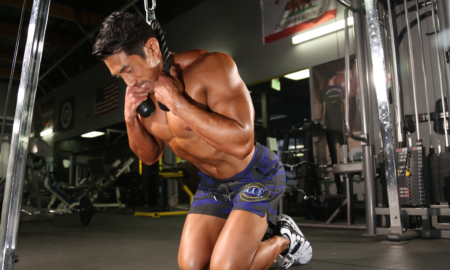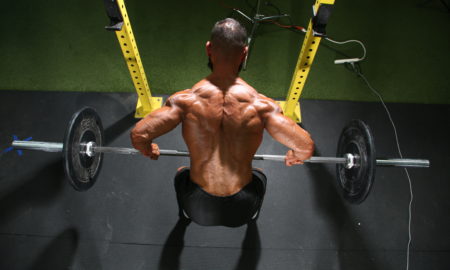Few bodybuilders appear to pay much attention to how fast they do an exercise. A typical repetition consists of a raising phase, in which the muscle shortens, and a lowering phase, in which it lengthens. The research differs on which phase produces more gains in size and strength. Most studies, however, suggest that the lowering phase—the eccentric, or negative, phase—may produce faster muscle gains. That’s because the muscle is under more stress during eccentric muscle contractions than during concentric, or positive, ones. The increased stress results in more damage to the muscle fibers. The body compensates for the damage by increasing the density of the damaged fibers, which results in increased muscle size and strength.
Findings about how exercise cadence affects muscle gains have led to such advice as taking three to four seconds to raise the weight followed by three to five seconds to lower it. Emerging evidence, however, indicates that this may not be the most efficient method of building muscle. Studies suggest that power training is, in fact, the most efficient way to boost muscle gains.
Power training with weights means you raise the weight as fast as possible, although still keeping it under control, and taking three to five seconds or more to lower it. One study compared fast and slow contractions in 12 young men training biceps. They trained one arm using fast contractions and the other using slow contractions. Using fast contractions resulted in more gains in type 2 muscle fibers, the ones most amenable to growth in size and strength. Another study had subjects do leg extensions three times a week for six weeks using slow, fast or mixed muscle contractions. Only the fast group showed significant muscle gains, an 11.2 percent enlargement of type 2 muscle fibers.
The latest study comparing power training to traditional weight training focused on older men. Twenty men, aged 69 to 79, were placed in two groups. Nine of them used traditional weight-training techniques, involving two to three seconds of concentric muscle contractions followed by two to three seconds of eccentric contractions. The other men engaged in power training, lifting the weight as fast as possible while maintaining a lowering phase of two to three seconds. Both groups did the same workout of basic upper- and lower-body exercises, resting 90 seconds between sets. They did three sets of eight reps for each exercise using a weight equal to 40 percent of one-rep maximum for the first two workouts. The weight was progressively increased to 50 percent of one-rep max for the third and fourth workouts, then 60 percent for the remaining training sessions, which continued for 10 weeks.
Power training was more effective in increasing muscle thickness in the older men.
Both groups gained muscle thickness in the biceps, but those using the power training gained more. Only the power trainees gained muscle thickness in their thighs. That’s highly significant because the loss of muscle with aging begins in the peripheral areas, particularly the lower body. The adage “The legs are the first to go” is all too true for most people. If you look at photos of aging former competitive bodybuilders, you’ll usually find that their legs show the greatest degree of muscle atrophy—although far less than would have occurred with a total lack of training.
Why would doing power training build muscle more efficiently? Muscle biopsies suggest that it causes more damage to muscle fibers than traditional concentric reps, leading to a greater degree of protein remodeling in the trained muscle
Type 2 muscle fibers are most susceptible to that type of damage. In short, with power training, you maximize training the muscle in all phases of the rep.
Another factor may involve anabolic hormones. In a study published in 2003, 10 young men, average age 24, did two common upper-body and two common lower-body weight exercises for four sets of 12 reps using a weight equal to 80 percent of one-rep maximum, with 90 seconds of rest between sets. The object of the study was to determine the hormone responses to concentric and eccentric muscle contractions. The results showed that while total and free testosterone levels rose slightly during both types of muscle contraction, only the concentric contraction produced a significantly greater release of growth hormone. The authors suggested that it was related to the higher intensity involved in such contractions. It’s easier to lower a weight than to lift it.
Perhaps the biggest danger when considering incorporating power training is not controlling the weight. While you want to move the weight as fast as possible, you should never resort to throwing it up. Not only does that take the stress off the muscle, but it can also result in serious injury. In fact, it would be prudent to thoroughly warm up before attempting power training. Always maintain control of the weight, and don’t forget to make the lowering phase last for three to five seconds for best results.
—Jerry Brainum
www.JerryBrainum.com
References
Shepstone, T.N., et al. (2005). Short-term high vs. Low-velocity isokinetic lengthening training results in greater hypertrophy of the elbow flexors in young men. J Appl Physiol. 98:1768-1776.
Nogueira, W., et al. (2009). Effects of power training on muscle thickness of older men. Int J Sports Med. 30(3):200-204.
Durand, R., et al. (2003). Hormonal responses from concentric and eccentric muscle contractions. Med Sci Sports Exer. 35:937-943.




















You must be logged in to post a comment Login